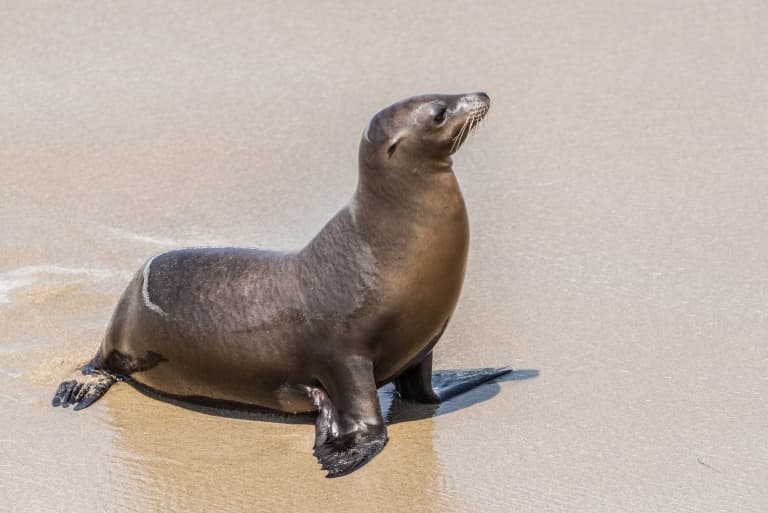Pinnipeds make up around 35 species of marine carnivorous mammals, separated into three families. You’ve got the Odobenidae, which is made up of walruses, and super easy to identify, but then things get a little confusing.
The remaining two families are the Otariidae, the “eared seals”, and the Phocidae, the “earless seals”.
From the common name, this should be simple enough, but there are so many exceptions it’s not as easy as it sounds to tell one from the other.

Let’s take a look at the differences between seals and sea lions.
1. They’re separated by 25 million years
As mentioned, the pinnipeds are the walruses, the true seals, and the “eared seals”. Their lineages have only recently been assessed at the molecular level, but it was once thought that the true seals evolved from a bear-like ancestor, while the eared seals evolved from an ancient mustelid ancestor.
As it turns out, both appear to have come from the mustelid line, splitting from their caniform lineage around 50 million years ago.
Early versions would have looked a bit like otters. They could probably walk on land a lot better than today’s models, but over time, they became more adept at ocean life, sacrificing terrestrial grace for marine athleticism.
Seals and sea lions would have split from one another about 25 million years ago, with the pair splitting the Northern and Southern Hemispheres loosely between them: the ancestors of seals took the Northern Hemisphere and the sea lion ancestors migrated and diversified Southward.
Around five million years later, ancestral walruses broke off from the eared seals.
2. Sea lions have ears
These eared seals are what are now known as sea lions. This family includes six living species of sea lion, but it complicates itself by also providing a space for eight so-called fur seal species.
This confusion is more of an issue with the common naming scheme, as fur seals could either be considered a distinct group that is neither a seal nor a sea lion, or they could be grouped with sea lions, on account of them having much closer relations with the sea lions than any true seal species.
The divergence between fur seals and sea lions was only six million years ago and is recent enough that both can produce fertile hybrids, suggesting the difference is negligible.
So, unless you want to be very pedantic, you could just go by whether or not the animal has ears. And if pedantry is your thing, you can count out fur seals entirely by looking at their size. Sea lion species are generally a lot larger than fur seal species.
If that doesn’t work, does it look like a bear or a dog? Fur seals look a lot more puppy-like than sea lions, who have a sort of bear look about them, with a shorter snout. 1

3. Seals can’t walk
You might have seen the lumbering sausage locomotion commonly employed by seals on land. Like many highly-adapted marine animals, they’re quite undignified unless they’re in the water.
Elephant seals are a perfect example of this, being the fattest of all seals, but all species are pretty obese-looking when it comes to shuffling their blubbery hydes across the beach.
Sea lions, on the other hand, have a far more flexible hip joint and are far more mobile on land as a result. If you see a pinniped – that’s not a walrus – walking on its back flippers, it’s a sea lion (or a fur seal – see above!).

4. Sea lions spend more time on land
This relative grace allows the sea lion to spend more time comfortably on land. Many seal species, on the other hand, will rarely return at all, other than to breed.
Even the gargantuan elephant seals spend two-thirds or more of their lives in the ocean, and most of this time beneath the surface.
5. Seals are more agile in the water
And practice makes perfect; being so well-adapted to life in the ocean makes seals the superior swimmers.
Those walking flippers of sea lions are used primarily as a rudder, meaning they need to propel themselves with their front flippers. But the rear limbs of the seal generate force, too, propelling them forward and giving them superior agility when escaping sharks.

6. Sea lions are faster
Still, the fastest pinniped is a sea lion. The California sea lion can rocket up to 40 km/h (25 mph) in short bursts, marginally faster than the fastest seal, the Grey seal, which has been clocked at a maxi of 37 km/h (23 mph) 2
7. Seals are quieter
This speed superiority has apparently gone to the head of the sea lion, who often won’t shut up about it. Sea lions are notoriously loud, barking about their accomplishments to anyone within hearing range.
They are more social, and more vocal than the relatively quiet seals, whose vocalisations are rarer and softer in general. 3
8. Sea lions are gregarious
This sociality is a big part of the difference between the two groups. Sea lions gather in groups of up to thousands, all plopping themselves out of the water and bellowing at one another.
Mating colonies of seals can be impressive too, but usually not quite in the league of sea lions. They prefer to stick to smaller groups and spend less time on land with one another in general. 4
Final thoughts
So there you have it – seals versus sea lions!
Seals and sea lions are very similar marine carnivores, with a few handy differences. If you can get over the common naming fiasco for the eared seals, it’s as simple as checking for external flaps on the side of the head, but there are also other handy differences to know about.
Perhaps the most obvious from a distance is how the animal is behaving. If it’s lumbering about in the sand like a fat aunt, it’s a seal. You can also listen: if it’s barking like an over-excited dog, it’s a sea lion.
Sea lions are generally bigger than seals, but there are too many exceptions to this to rely on it, so it’s better to look at their faces. Seals have rounder, shorter noses, and sea lions have longer snouts, more like those of dogs.
Ultimately, while very similar, the differences are stark enough that once you get familiar, you’ll be confidently correcting people on the internet in no time.
Fact Sources & References
- https://www.wilddunedin.nz/stories/fur-seal-or-sea-lion-how-to-tell-the-difference
- https://nationalzoo.si.edu/animals/news/dare-compare-whats-difference-between-sea-lions-and-seals
- https://seaworld.org/animals/all-about/california-sea-lion/communication/
- https://animals.sandiegozoo.org/animals/sea-lion
